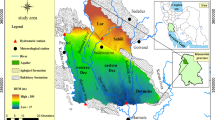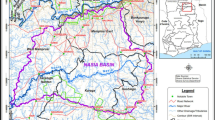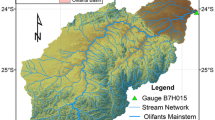Abstract
Groundwater is one of the most imperative natural resources utilized worldwide for a variety of purposes. Agricultural, domestic and industrial usage of this is increasing manifold. The available surface water resources are not enough and are inadequate to meet the drinking and irrigation requirements of the crops. Groundwater has more essential advantages as compared with surface water. Climate change is affecting the global natural resources, particularly the water cycle consequently groundwater resources are observed to be compromised worldwide. Groundwater flow models could be very useful tools for the efficient management of groundwater resources if properly calibrated and validated. The models can help to manage the aquifer system and its related features in realtime. Different future scenarios can be developed using global and regional climate model data to simulate the impact of climate change on groundwater resources. The climate models data can be downscaled using dynamic or statistical techniques however the authenticity and reliability of these downscaled values are still questionable. For the assessment of climate change impacts on groundwater resources, it is imperative to understand the extent and magnitude of groundwater vulnerability to droughts, over-exploitation as well as deterioration in its quality. To understand the spatial and temporal availability of groundwater a better quantification of the regional water budget is also required. This information can be a good source of evidence for the groundwater managers dealing with present and future climate change regimes. The future sustainable availability of groundwater is highly dependent on long term climate trends and their possible implications on groundwater recharge and water level fluctuations.
Access this chapter
Tax calculation will be finalised at checkout
Purchases are for personal use only
Similar content being viewed by others
References
Adane GW (2014) Groundwater modeling and optimization of irrigation water use efficiency to sustain irrigation in Kobo Valley, Ethiopia UNESCO-IHE]
Anderson MP, Woessner WW (1992) Applied modeling of groundwater flow-Simulation of flow and advective transport. Academic Press, New York
Anderson MP, Woessner WW, Hunt RJ (2015) Applied groundwater modeling: simulation of flow and advective transport. Academic press
Arora NK (2018) Environmental sustainability—necessary for survival. Springer
Benz SA, Bayer P, Blum P (2017) Global patterns of shallow groundwater temperatures. Environ Res Lett 12(3):034005
Bogardi JJ, Bharati L, Foster S, Dhaubanjar S (2021) Water and its management: dependence, linkages and challenges. In: Handbook of water resources management: discourses, concepts and examples. Springer, pp 41–85
Bouraoui F, Vachaud G, Li L, Le Treut H, Chen T (1999) Evaluation of the impact of climate changes on water storage and groundwater recharge at the watershed scale. Clim Dyn 15(2):153–161
Change C (2007) IPCC fourth assessment report. Phys Sci Basis 2:580–595
Christensen J, Hewitson B, Busuioc A, Chen A, Gao X, Held I, Jones R, Kolli R, Kwon W, Laprise R (2007) na Rueda VM, mearns L, Menéndez CG, Raisanen J, Rinke A, Sarr A, Whetton P. 2007. Regional climate projections. In: Climate change
Cohen D, Person M, Daannen R, Locke S, Dahlstrom D, Zabielski V, Winter TC, Rosenberry DO, Wright H, Ito E (2006) Groundwater-supported evapotranspiration within glaciated watersheds under conditions of climate change. J Hydrol 320(3–4):484–500
Cooley RL (1997) Confidence intervals for ground‐water models using linearization, likelihood, and bootstrap methods. Groundwater 35(5):869–880. https://onlinelibrary.wiley.com/doi/pdf/10.1111/j.1745-6584.1997.tb00155.x
Dagan G (1982) Stochastic modeling of groundwater flow by unconditional and conditional probabilities: 2 The solute transport. Water Resour Res 18(4):835–848
De Caceres M, Martin-StPaul N, Turco M, Cabon A, Granda V (2018) Estimating daily meteorological data and downscaling climate models over landscapes. Environ Model Softw 108:186–196
Dettinger M, Earman S (2007) Western ground water and climate change—pivotal to supply sustainability or vulnerable in its own right? Ground Water Scientists Eng Newslett 4–5
Dragoni W (1998) Some considerations on climatic changes, water resources and water needs in the Italian region south of 43 N. In: Water, environment and society in times of climatic change. Springer, pp 241–271
Fant C, Schlosser CA, Strzepek K (2016) The impact of climate change on wind and solar resources in southern Africa. Appl Energy 161:556–564
Flato G, Marotzke J, Abiodun B, Braconnot P, Chou SC, Collins W, Rummukainen M (2014) Evaluation of climate models. In Climate change 2013: the physical science basis. Contribution of working group I to the fifth assessment report of the intergovernmental panel on climate change. Cambridge University Press, pp 741–866
Galafassi D, Kagan S, Milkoreit M, Heras M, Bilodeau C, Bourke SJ, Merrie A, Guerrero L, Pétursdóttir G, Tàbara JD (2018) ‘Raising the temperature’: the arts on a warming planet. Curr Opin Environ Sustain 31:71–79
Genereux DP, Hooper RP (1998) Oxygen and hydrogen isotopes in rainfall-runoff studies. In: Isotope tracers in catchment hydrology. Elsevier, pp 319–346
Green TR, Taniguchi M, Kooi H, Gurdak JJ, Allen DM, Hiscock KM, Treidel H, Aureli A (2011) Beneath the surface of global change: impacts of climate change on groundwater. J Hydrol 405(3–4):532–560
Griggs DJ, Noguer M (2002) Climate change 2001: the scientific basis. Contribution of working group I to the third assessment report of the intergovernmental panel on climate change. Weather 57(8):267–269
Guo D, Wang H (2016) Comparison of a very-fine-resolution GCM with RCM dynamical downscaling in simulating climate in China. Adv Atmos Sci 33:559–570
Gutowski Jr WJ, Vörösmarty CJ, Person M, Ötles Z, Fekete B, York J (2002) A coupled land‐atmosphere simulation program (CLASP): calibration and validation. J Geophys Res Atmos 107(D16):ACL 3-1–ACL 3-17
Hewitson B, Crane R (2006) Consensus between GCM climate change projections with empirical downscaling: precipitation downscaling over South Africa. Int J Climatol J Royal Meteorol Soc 26(10):1315–1337
Hosseinzadehtalaei P, Tabari H, Willems P (2017) Uncertainty assessment for climate change impact on intense precipitation: how many model runs do we need? Int J Climatol 37:1105–1117
Huggett RJ (1991) Ice and water. In: Climate, earth processes and earth history. Springer, pp 49–75
Huntington TG (2006) Evidence for intensification of the global water cycle: review and synthesis. J Hydrol 319(1–4):83–95
IPCC (2007) The physical science basis. Contribution of working group to the fourth assessment report of the intergovernmental panel on climate change. Cambridge University Press, Cambridge, UK and NY, USA, p 996
Issar AS (2004) Climate changes during the Holocene and their impact on hydrological systems
Jones PD, Wigley T (2010) Estimation of global temperature trends: What’s important and what isn’t. Clim Change 100(1):59–69
Kresic N (2006) Hydrogeology and groundwater modeling. CRC Press
Kumar C (2015) Modelling of groundwater flow and data requirements. Int J Modern Sci Eng Technol 2(2):18–27
Kundzewicz ZW, Mata LJ, Arnell N, Doll P, Kabat P, Jimenez B, Miller K, Oki T, Zekai S, Shiklomanov I (2007) Freshwater resources and their management
Labat D, Goddéris Y, Probst JL, Guyot JL (2004) Evidence for global runoff increase related to climate warming. Adv Water Resour 27(6):631–642
Lamy F, Arz HW, Bond GC, Bahr A, Pätzold J (2006) Multicentennial‐scale hydrological changes in the Black Sea and northern Red Sea during the Holocene and the Arctic/North Atlantic Oscillation. Paleoceanography 21(1)
Li R, Merchant JW (2013) Modeling vulnerability of groundwater to pollution under future scenarios of climate change and biofuels-related land use change: a case study in North Dakota, USA. Sci Total Environment 447:32–45
Lin YF, Anderson MP (2003) A digital procedure for ground water recharge and discharge pattern recognition and rate estimation. Groundwater 41(3):306–315. https://onlinelibrary.wiley.com/doi/pdf/10.1111/j.1745-6584.2003.tb02599.x
Loáiciga HA (2009) Long-term climatic change and sustainable ground water resources management. Environ Res Lett 4(3):035004
Mallick J, Khan RA, Ahmed M, Alqadhi SD, Alsubih M, Falqi I, Hasan MA (2019) Modeling groundwater potential zone in a semi-arid region of Aseer using fuzzy-AHP and geoinformation techniques. Water 11(12):2656
Nkhonjera GK, Dinka MO (2017) Significance of direct and indirect impacts of climate change on groundwater resources in the Olifants River basin: a review. Glob Planet Change 158:72–82
Pittock AB (2017) Climate change: turning up the heat. Routledge
Randall D, Wood R, Bony S, Colman R, Fichefet T, Fyfe J, Kattsov V, Pitman A, Shukla J, Srinivasan J (2007) Climate models and their evaluation (Chapter 8)
Sadeghi-Tabas S, Samadi SZ, Akbarpour A, Pourreza-Bilondi M (2017) Sustainable groundwater modeling using single-and multi-objective optimization algorithms. J Hydroinf 19(1):97–114
Sahoo S, Jha MK (2017) Numerical groundwater-flow modeling to evaluate potential effects of pumping and recharge: implications for sustainable groundwater management in the Mahanadi delta region, India. Hydrogeol J 25(8):2489–2511
Scibek J, Allen DM (2006) Modeled impacts of predicted climate change on recharge and groundwater levels. Water Res Res 42(11)
Soden BJ, Collins WD, Feldman DR (2018) Reducing uncertainties in climate models. Science 361(6400):326–327
Soldatenko S (2019) Estimated impacts of climate change on eddy meridional moisture transport in the atmosphere. Appl Sci 9(23):4992
Solomon S, Manning M, Marquis M, Qin D (2007) Climate change 2007-the physical science basis: working group I contribution to the fourth assessment report of the IPCC (vol 4). Cambridge University Press
Stoll S, Hendricks Franssen HJ, Butts M, Kinzelbach W (2011) Analysis of the impact of climate change on groundwater related hydrological fluxes: a multi-model approach including different downscaling methods. Hydrol Earth Sys Sci 15(1):21–38
Sulzbacher H, Wiederhold H, Siemon B, Grinat M, Igel J, Burschil T, Hinsby K (2012) Numerical modelling of climate change impacts on freshwater lenses on the North Sea Island of Borkum using hydrological and geophysical methods. Hydrol Earth Sys Sci 16(10):3621–3643
Taylor RG, Scanlon B, Döll P, Rodell M, Van Beek R, Wada Y, Longuevergne L, Leblanc M, Famiglietti JS, Edmunds M (2013) Ground water and climate change. Nat Clim Chang 3(4):322–329
Thomas BF, Behrangi A, Famiglietti JS (2016) Precipitation intensity effects on groundwater recharge in the southwestern United States. Water 8(3):90
Todd D, Mays L (2005) Groundwater hydrol. Willy and Sons Inc., New York Google Scholar
Torak LJ (1993) A MODular Finite-Element model (MODFE) for areal and axisymmetric ground-water-flow problems, part 3: design philosophy and programming details. US Department of the interior
Wilby RL, Wigley TM (1997) Downscaling general circulation model output: a review of methods and limitations. Prog Phys Geogr 21(4):530–548
Yang M, Yao T, Wang H, Gou X (2006) Climatic oscillations over the past 120 kyr recorded in the Guliya ice core, China. Quatern Int 154:11–18
Yao Y, Zheng C, Liu J, Cao G, Xiao H, Li H, Li W (2015) Conceptual and numerical models for groundwater flow in an arid inland river basin. Hydrol Process 29(6):1480–1492
Zhou Y, Herath H (2017) Evaluation of alternative conceptual models for groundwater modelling. Geosci Front 8(3):437–443
Zhou Y, Li W (2011) A review of regional groundwater flow modeling. Geosci Front 2(2):205–214
Zhou Y, Zwahlen F, Wang Y, Li Y (2010) Impact of climate change on irrigation requirements in terms of groundwater resources. Hydrogeol J 18(7):1571–1582
Author information
Authors and Affiliations
Corresponding author
Editor information
Editors and Affiliations
Rights and permissions
Copyright information
© 2024 The Author(s), under exclusive license to Springer Nature Switzerland AG
About this chapter
Cite this chapter
Awais, M., Arshad, M., Hopmans, J.W., Baig, M.B., Najim, M.M.M. (2024). Analysis of Groundwater Regimes Utilizing Hydrogeological Modeling Under Climate Change Scenarios. In: Behnassi, M., Al-Shaikh, A.A., Gurib-Fakim, A., Barjees Baig, M., Bahir, M. (eds) The Water, Climate, and Food Nexus. Springer, Cham. https://doi.org/10.1007/978-3-031-50962-9_10
Download citation
DOI: https://doi.org/10.1007/978-3-031-50962-9_10
Published:
Publisher Name: Springer, Cham
Print ISBN: 978-3-031-50961-2
Online ISBN: 978-3-031-50962-9
eBook Packages: Earth and Environmental ScienceEarth and Environmental Science (R0)




